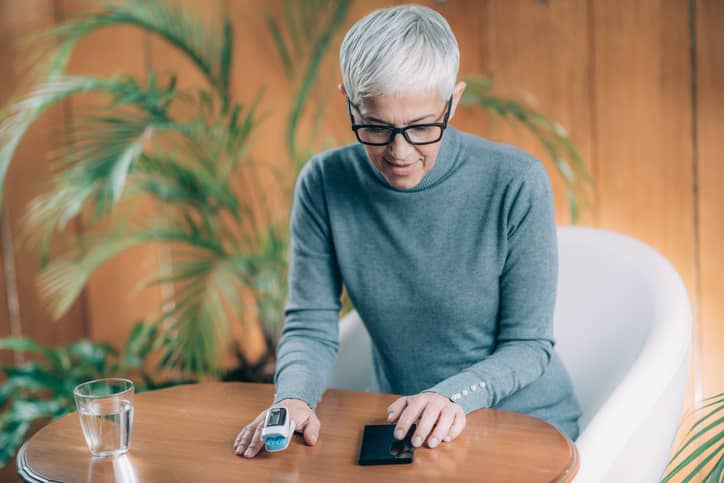During the COVID-19 pandemic, many people have gone to hospital later than they should have done, as they didn’t realise how ill they were.
One of the things that leads to hospitalisation with COVID-19 is low oxygen levels. Some experts have suggested that using pulse oximeters at home could help get people to hospital sooner, so they can be treated more effectively.
Read on to learn more about pulse oximeters and find out how you might use one at home.
What is a pulse oximeter?
A pulse oximeter is a small medical device that measures your heart rate and the amount of oxygen in your blood, to check how well you’re breathing.
They’re most commonly used by doctors and nurses, but they’re also available to buy from pharmacies and online to use at home.
Pulse oximeters and COVID-19
COVID-19 can sometimes make you have very low oxygen levels, without causing shortness of breath or making you feel really unwell. Known as ‘silent hypoxia’, this can make it hard to know when someone is in need of urgent medical attention.
This has led some experts to suggest that people should buy pulse oximeters, so they can check their oxygen levels at home.
In the UK, the health service is running a scheme that gives pulse oximeters to some vulnerable people with COVID-19 symptoms, so they can check their oxygen levels 3 times a day. If they need more urgent treatment, they can then go to hospital at the right time.
However, it’s important to know that a pulse oximeter can’t diagnose COVID-19. You should get a test if you have symptoms or think you have been infected.
How does a pulse oximeter work?
In a medical setting, a pulse oximeter is clipped on to one of your fingers or your earlobe. Home devices are usually attached to a finger.
A pulse oximeter shines 2 types of light through your finger – red light and infrared light. Blood that contains lots of oxygen absorbs more infrared light and lets more red light through, while blood with a low amount of oxygen does the opposite. The oximeter measures this to give you a blood oxygen reading.

How to use a finger pulse oximeter at home
Pulse oximeters are painless and easy to use. It’s always best to get advice from a doctor about using one at home, as well as following any instructions that come with it. But generally, the steps to use one are:
-
Wash your hands and remove any nail polish or false nails.
-
Make sure your hand is warm to the touch.
-
Place your hand on your chest and rest it there for 5 minutes.
-
Switch on the oximeter and clip it onto a finger – either the one next to your thumb or your middle finger.
-
Watch the numbers on the oximeter. Once they’ve stopped changing, they are your results, or ‘reading’.
Pulse oximeter readings
Now you’ve taken the readings, what do they mean?
The number under ‘%SpO2’ tells you the percentage of oxygen in your blood. The number under ‘PR bmp’ is your heart rate.
Normal pulse oximeter readings for %SpO2 range from 95% to 100%.
If your oxygen level reading is 93 or 94%, get medical advice as soon as possible. If your oxygen level is 92% or below, seek emergency medical help.
The pros and cons of using a pulse oximeter at home
There are advantages and disadvantages to using a pulse oximeter yourself. These include:
Pros
- it may help you to get medical attention more quickly
- checking your readings may give you peace of mind
Cons
- readings can sometimes be poor or inaccurate
- there is a cost involved in buying one
When to seek medical advice
If you’re going to buy a pulse oximeter, it’s important to do your research. It’s best to talk to your healthcare provider before using one at home.
If your oxygen level reading is 93 or 94%, get medical advice as soon as possible. If your oxygen level is 92% or below, seek emergency medical help.
Key points
- pulse oximeters measure your heart rate and oxygen levels
- you can buy a pulse oximeter to use at home
- they may make you get medical attention sooner – but they can also be inaccurate
- it’s best to talk to your healthcare provider before using a pulse oximeter
- if your oxygen level reading is 93 or 94%, get medical advice as soon as possible. If your oxygen level is 92% or below, seek emergency medical help






